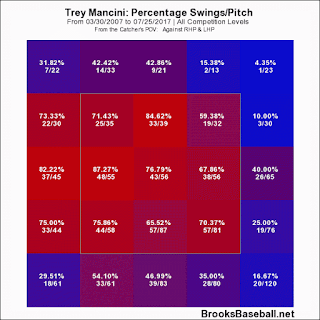Is a mid-level veteran rotation arm really going to move the needle on this team and propel them to a wild card spot? No, it won’t. It will help (in the case of the Jeremy Hellickson trade, it helps in providing innings), but the team would also need improvement from all of their core players, specifically the starting rotation. So the Orioles should be selling and the fact that we’ve made it this far without any moves has to be a little troubling (again, I’m not counting Hellickson). But fear not, as of the time of this posting (9 AM ET), there is still 7 hours for the team to come to its senses and deal some players for something in return.
The players who are set to become free agents after the season are the obvious places to start, especially considering that the team has plans on competing in 2018. While there are 7 players set to enter free agency in the offseason (including Welington Castillo, who has a $7 million player option), none are likely to bring back returns that will help Baltimore next year or in the future.
Minimal Return
- Seth Smith
- Welington Castillo
Hyun-Soo Kim
- Chris Tillman (someone needs to pitch innings)
- Ryan Flaherty
Sure the Orioles could (i.e. should) also look to clear the salary owed to Mark Trumbo, Chris Davis, and/or Darren O’Day, but their combination of performance and remaining money owed doesn’t lead one to believe that anyone would be willing to take them, even for minimal return. So, if the Orioles are planning on being competitive in 2018 (which, in my opinion is debatable), the one player they absolutely need to trade today before the deadline is Zach Britton.
While it appears that the Orioles will not lose much from their free agents, they will have plenty of holes to fill. And as we’ve discussed before on this site, there isn’t anything in the high minors ready to contribute next year (if you’re a believer in Austin Hays and Ryan Mountcastle, I think the best case scenario is they can play their way to Baltimore after the 2018 All-Star break). The Orioles will need to fill (at least) 2 rotation spots, a SS (or 3B depending on where they decide to play Manny Machado), an upgrade in one (if not 2) outfield spots, and possibly even another catcher. Those holes can’t all be filled via free agency, and even if they could, it’s unlikely the team would spend enough for the team to be markedly improved.
Zach Britton is the one player that the Orioles can trade at the deadline whose return could fill one or two of those holes in 2018. Granted, it’s unlikely that he’ll bring back a superstar on the cusp of a major league call-up, but a package of 1 or 2 high minors prospects who could be solid contributors and 1 or 2 well-regarded prospects in the low minors is reasonable. If the Orioles aren’t going to trade Machado, then Britton is the one guy who can bring back some talent that can help the team sooner rather than later.
Barring any sort of injury, Britton’s value shouldn’t decline between now and the offseason, so it’s true that the Orioles could wait to get a package they like until then, but I do believe the time is now to trade Britton. He is the kind of elite bullpen arm that literally every contender could use, and the presence of Britton even on an already GREAT bullpen, makes that team much more dangerous in the postseason. And while there may be more teams looking for Britton’s services in the offseason, I think the Orioles can capitalize on some trade deadline desperation and sell Britton as someone who can impact 2 seasons.
Obviously, if Baltimore doesn’t get a deal that they like, they shouldn’t accept a deal just for the sake of accepting it. And in fact, with Britton’s injury earlier this season, some teams may be skeptical of whether or not Britton is healthy, which would be a cause of concern in acquiring him (another may be his salary). However, based on what Britton has shown since returning from injury, he appears to be pretty similar to what he was last year. The time to trade Zach Britton is today, and while losing him may hurt, the one thing the Orioles have been good at is finding cheap and effective relief arms. Britton makes every team in contention much better, and trading him is the best chance the Orioles have to give this group of players one last championship run in 2018.









